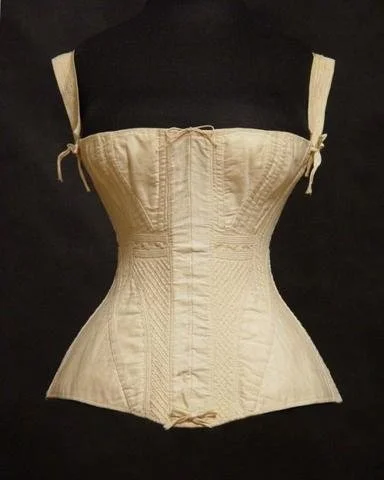The Corset: A History and Evolution
BY ALICE O’RORKE
The corset is a constrictive item of clothing that we could all recognise from cinematographic portrayals and the history books. Several scenes on the screen enact the ordeal of cinching a corset in, pulling the strings as tightly as they can bear, all with the intention of creating the smallest waist physically possible, irrespective of any limitations on movement.
Bridgerton (2020)
The history of the corset is a long one. Although this term was only actually popularised during the Victorian era, evidence of corset-like garments can be seen as early as 1600 BC. Whilst the shape of this undergarment has changed throughout time alongside the morphing ideals of feminine beauty, the description in Britannica as an ‘article of clothing worn to shape or constrict the waist’ effectively describes what we know of the corset; with this ‘constriction’ aptly emblematising its use as a patriarchal weapon to restrict women.
‘Corset’ is the term that describes the boned and lace supportive item of clothing, and this refers more to the undergarment donned in the Victorian times. But before this, undergarments worn were more accurately defined as ‘stays’ or ‘bodices’. The term ‘stay’, most likely coming from the French ‘estayer’ meaning ‘to support’, was used mainly to support and hold up the bust, rather than to cinch in the waist. This was commonly worn in the Georgian period, and was a boned, conical item with a flat front that provided a solid base to drape other garments, such as the hooped skirt and padding. Although the stay itself was not restrictive, the hooped skirt certainly would not have allowed for easy mobility. Following this, the attire of the Regency period focused on frills, correlating with the French monarchy, and undergarments were intended to emphasise natural curves.
The first ‘corset’ was used in France in the 1770s, although at that time this would have referred to a stay without any boning. However, in the Victorian period, the use of boning became favourable again, and so the corset became known as a waist-cinching, restrictive garment. This style aimed to create the ideal hourglass shape in the 1800s, and the ‘S’ figure of the 1900s. Whilst the corset was adopted by aristocracy in the 18th century, it filtered down into the lower classes, who remodelled the traditional whalebone corset using reeds and other less-expensive materials. The corset therefore was deemed a desirable possession for restriction. Britannica notes that young children often wore corsets or stays ‘to ensure straight spines and pleasing body shapes later in life.’ Whilst a straight spine and good posture is understandably desirable, the concept of ‘pleasing body shapes’ being projected onto young children is quite disturbing. Here we see the pressures on women to appear petite and desirable filtering down into how children are taught to present themselves; this was evidently imposed at a very young age.
The discussion of corsets as detrimental to physical health began as early as the 19th century, with several doctors criticising them for causing ‘respiratory diseases, deformity to the ribs, damage to internal organs, birth defects, and miscarriages,’ as Vogue states, whilst also leading to possible ‘fainting and lowered vitality’. But it wasn’t until the mid-twentieth century that corsets were altogether abandoned. After the Suffrage movement and two World Wars, the women’s effort required more mobility for work, making corsets impractical and outdated. Despite this, the mentality created by corsets, of aspirations for a petite shape and a tiny waist, was internalised into the diet culture. This mentality can still be seen today, with increasing pressure due to social media and the “perfect body” trope.
However, recently we have seen a resurgence of the corset in fashion. They are used as a part of fetishistic practices, such as BDSM, where the idea of bondage and submission are played upon in a sexually liberating way, as well as for burlesque. They have also retaken a role in everyday dress, with the corset replacing the function of a top, and thus worn on the outside of clothing rather than as an undergarment. Furthermore, the corset no longer focuses solely on women, with some companies such as ‘Innova Corsetry’ creating collections of male vest corsets, with the majority of their advertising geared towards men.
Innova Corsetry vests
The fact that corsets now act as items of clothing, rather than solely undergarments, demonstrates how they are representative of empowerment and liberation. The corset now acts as a tool to feel sexy, rather than sexualised. The reclaiming of this item of clothing represents a rejection of a patriarchal view of constricting women. In fact, since Bridgerton aired on Netflix, shopping services including ‘Like To Know It’ and ‘Lyst’ have revealed that searches for corsets have increased by more than 100 per cent. The age of corset empowerment is upon us.




